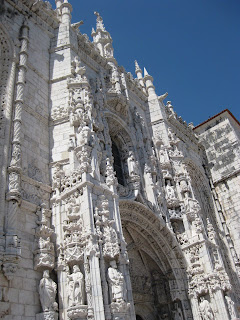I've received a few complaints that Terry has been slacking off on the beer sampling - never fear, he has been hard at it and here is the latest:
Delerium Nocturnum
Belgium
Nice. Rich red ale. Liked this a lot.
Delerium Tremens
Belgium
Not so nice. Strange mothball taste and far too hoppy for mine. Handed back half of it for a new glass.
Kingway Lager
China
Not a lot to this. A bit flat, a bit flavourless. Not one I’d look for again.
Radeberger Pilsner
Germany
Classy. This is a great beer. Rich, thick, malty.
Twisted Pine Amber Ale
Boulder, Colorado.
Nice example but a bit smoky. Recommended accompaniment is cheese and I’d go along with that. One to remember as being drinkable for sure.
Czechvar Lager
Czech Republic.
A fine example of Bohemian brewing. This is an old brewery with a superb lager on offer. Traces its roots back to 1265 but produced by this brewery only from 1895. Up there with Lowenbrau, Spaten, Pilsener Urquell etc. Top class.
Pilsner Urquell
Pilsen, Bohemia
The first Pilsner in the world was this one, made in Bohemia in about 1842. This is one great beer. I had a six of these up on the Chesapeake but for some reason forgot to write it up. Had another two tonight at our local, the Riverside Market. One of the world’s great beers.
A great session with John and Vicki of Kansas off an Island Packet next to us, Bruce from Wild Matilda and Jerry from Player. All six of us rode back to the marina on our bikes in the dark on a warm South Florida night. Very pleasant.
Bahamas
Kalik
Cheapest beer in the Bahamas, where stuff is NOT cheap. Unless it’s local rum, in which case it’s $8.50 per litre. I kid you not, $8.50 per litre for good dark rum. Anyway, back to the beer – in a country of horrendous import duties, this is a local brew you can usually get at an offer of 3 for $5, which makes it eminently friendly price wise. It’s eminently drinkable too, with a light-ish taste but with good flavor. Nice stuff.
Bermuda in general.
Heineken seems to have a mortgage on the place. Not the best but OK.
Portugal
Sagres is everywhere and cheap at usually around 0.80 a 300ml bottle. Not bad, easy to pick from a lineup and certainly a good choice.
Sagres (5,0% abv): is a pale lager (branca) made of 100% natural product, brewed according to exclusive traditional methods with water, malt, cereals which have not been malted and a rigorous selection of the finest hops. No additives or preservatives are used in its brewing. Moderately rich, it has a dry and pleasantly bitter taste. It is light and has a golden colour. This is generally my day to day beer here and without a doubt it is a good drink.
Sagres Preta (4,3% abv): is a dark Munich type of beer, moderately rich, with a pleasant caramel “bouquet”. For many, it is “the alternative drink to an immense minority who want to know the difference”. For many years, Sagres Preta was the only dark ale in the domestic market. Very nice indeed but like most dark beers there’s a limit (maybe three?)
Sagres Bohemian
I have 6 of these in the fridge but have yet to try one. Too busy drinking the other stuff.
Imperial
Full flavor, nice to drink.
Imperial Preta is their dark beer – it has “stout” on the label but it tastes to me more like a dark lager. I thought I didn’t like stout but then what do I know. I suppose I’ll have to go and try a Guinness again to see if I was right or wrong. This brewery also makes
Super Bock
Everywhere. All over the place. Major sponsor of many things so you see the name all over Portugal. Lucky it’s good stuff. Eminently drinkable. Been around since about 1942 and supposedly “the” premium beer on Portugal. Who’s to argue, though Sagres is up there also.
This brewery also makes
Cristal
Which is also good stuff. Not much more expensive than Sagres. Probably a bit crisper and with a longer flavor hanging around
Tagus
On tap in the marina. Cheaper than Sagres and Imperial. A bit of a fruity taste in there that I don’t like much. Not crisp enough. Pass me.
Perlenbacher Premium Pils
At Lidl supermarket, this was E3.19 for 6 x ½ litre bottles. Bargain. Not the world’s tastiest beer but drinkable and refreshing. I mean, 60p a 500ml bottle.
Veltins Pilsener
An old-ish family owned brewery. Highly regarded Pilsener. Nice 4.8%. Since 1994 it has been run by Susanne Veltins. Owns a brewery and a football stadium. What a catch. Has a partner though.
Very nice, crisp and clear. Has quite a punch to it, probably because it’s 500mls a can. Like most stuff in Portugal, it’s about €0.60.
Keniger
Made by Browar van Pur. The Wiki is in Polish which none of you speak so I’ve left it out.
4.8%. A great Polish beer from Polnocny. Light and fizzy. Another bargain at .68c per 500ml can. The beer snobs don’t like this one much but they know what?



















